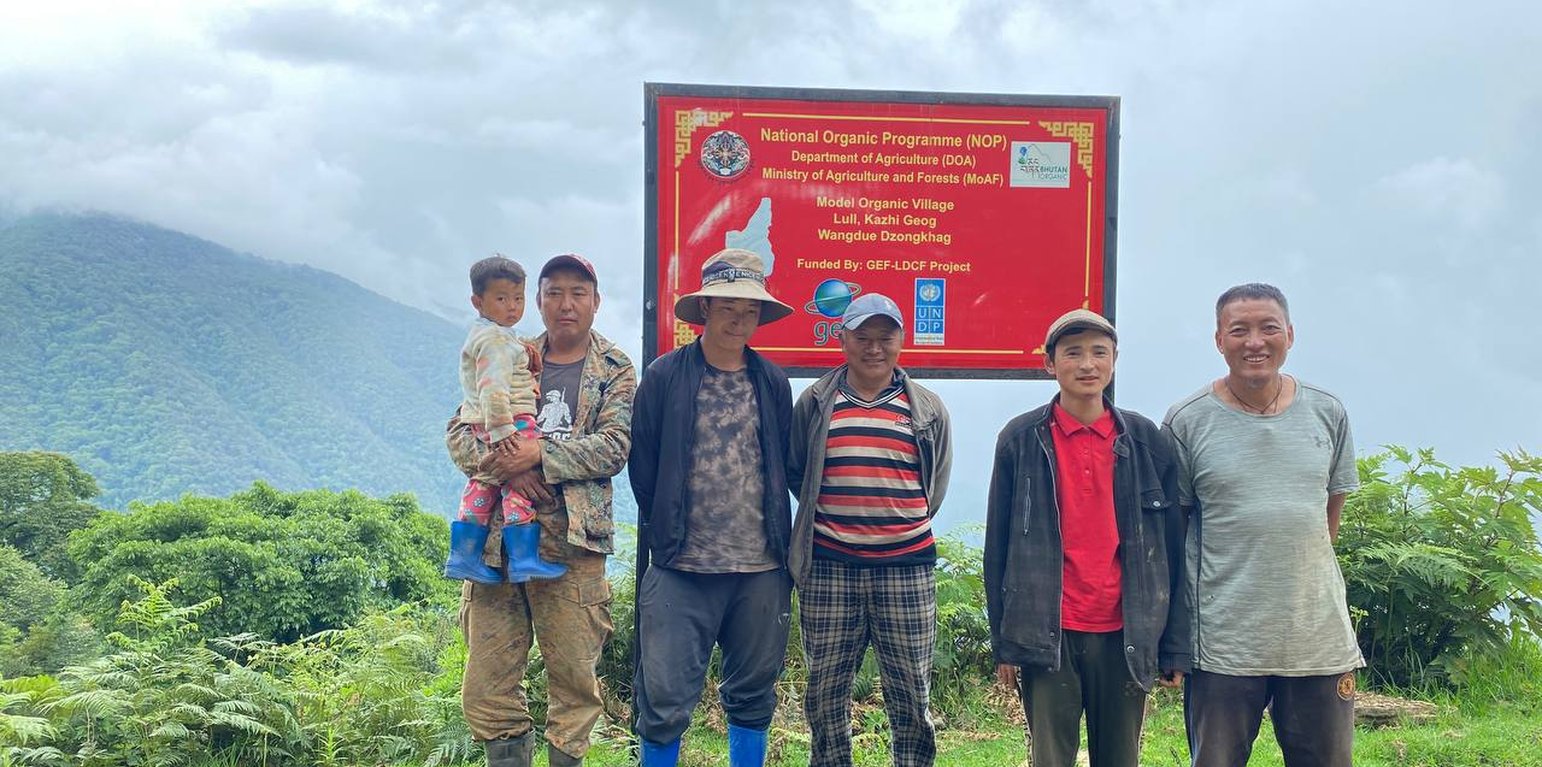Model Village Approach to Scale out Organic Agriculture
(بوتان)
Petoen Gi Yue Ngoe Zin Baedhi Rangzhin Sanam Dharchhab Tangthab (དཔེ་སྟོན་གྱི་གཡུས་ངོས་འཛིན་འབད་འདི་རང་བཞིན་སོ་ནམ་དར་ཁྱབ་བཏང་ཐབས།)
الوصف
Organic agriculture includes a variety of farming systems that advance the sustainable production of food and fibres, prioritizing human health, and environmental, social, and economic aspects. The main objective of the model village approach is to promote the commercialization of organic farm produce.
Organic farming is a system of agricultural production based on the use of natural processes and resources. Organic farming is on the rise worldwide. Until 1961, when chemicals were introduced to Bhutanese farmers, Bhutan was 100% organic. There were no chemicals to buy and no chemicals to use. There were no genetically modified seeds to buy and no genetically modified seeds to use. Farmers were required to weed their field by hands instead of spraying butachlor, a powerful pesticide used in paddy fields. According to Dzongkhag agriculture officer (DAO), a farmer in Wangdue, said that organic agriculture is "what we used to do." Traditional farming methods in Bhutan are organic and the departure from that has been a recent movement. But young farmers who started after the introduction of chemicals cannot remember a time when chemicals were not a part of their farming practices. The increase in chemicals is a recent trend, and depending on which chemical is under consideration the trend has either stagnated or grown. According to the national organic program, the use of fertilizer has remained constant over the last thirty years. On the other hand, the use of synthetic herbicides has grown each year. The primary example of herbicides used are butachlor in rice paddy fields and metribeuzin in potatoes (Hokenson, 2014).
The Department of Agriculture in collaboration with Dzongkhag Agriculture Office and Gewog Administration identified Lull village, Lengbi Chiwog of Kazhi gewog as a "Model Organic Village" to improve the livelihoods of people through crop diversification and income generation. Lull village was identified as an organic village in 2018. The main objective of this approach is to promote the commercialization of organic farm produce through post-production and value addition (Dorji, 2022).
In 2013, 51-year-old Tashi Bidha was the only farmer in Lull, a village situated in the Kazhi gewog region, approximately 40 kilometers from Bajo, Wangdue. The village, comprising a mere eight households, was classified as one of the most isolated in the Wangdue region. Lull is presently the first prosperous organic village in Wangdue. This began in 2013 with the initiative of one individual to establish road connectivity. Phub Dorji, a native of Lull, remarked that the village lacked roads and electricity at the time.
The village's application for road connectivity was rejected in 2013 due to its failure to satisfy the minimum threshold of 20 households. Many were apprehensive when Phub Dorji suggested that they make their own road. Following some deliberation, however, six households reached a consensus. Six households contributed more than Nu.500,000 towards the repair of the 8.8 kilometers of road in Lull. Electricity arrived in the village months after the road was constructed. The community consented to transition to organic practices in 2017.
Wangdue’s agriculture extension stated the village received potato seeds, asparagus seedlings, bio-fertiliser, bio-pesticide and vermicomposting among others. The village has five polyhouses, and they have first-hand training in bio-pesticide preparation. They are now technically equipped. Lull previously cultivated wheat, barley, and chili. The village currently produces more than eleven different types of commodities and distributes its goods in Phuentsholing, Thimphu, Punakha, and Wangdue. Potatoes, garlic, and chili peppers are among the principal cash commodities of Lull. Presently, income generation has increased to Nu 770,000 since the transition to organic practices.
الموقع
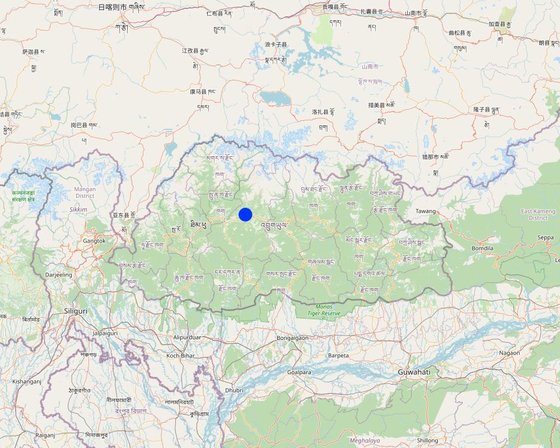
الموقع: Kazhi, Lull village, Wangdue phodrang, بوتان
المرجع الجغرافي للمواقع المختارة
تاريخ البدء: غير متاح
سنة الإنهاء: غير متاح
نوع النهج
-
تقليدي/أصلي
-
مبادرة محلية حديثة/مبتكرة
-
قائم على مشروع/برنامج
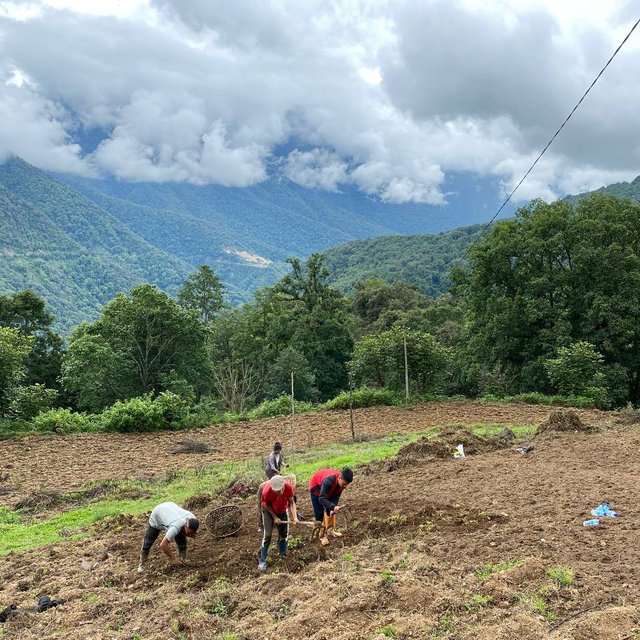
Organic farm of Lull Village, Lengbi Chiwog. (Niki Rai)
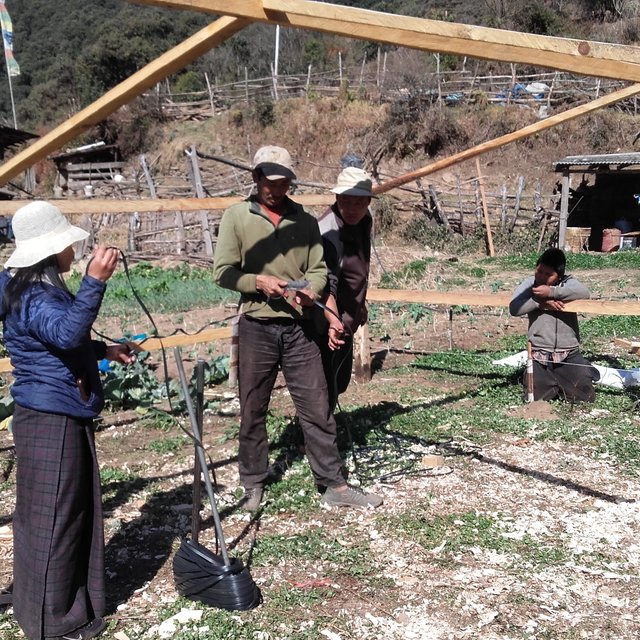
Hands on training on Low Cost Plastic House Construction to the Land Users. (Mr. Sangay Wangdi, Senior Extension Supervisor, (Dzongkhag Organic Focal))
غايات النهج والبيئة المواتية
الغايات/الأهداف الرئيسية للنهج
To improve the livelihoods of people by through crop diversification and income generation while promoting the commercialization of organic farming through post-production and value-addition for independency and self sufficiency.
الشروط التي تمكن من تنفيذ التقنية/التقنيات المطبقة في إطار النهج
-
المعايير والقيم الاجتماعية /الثقافية/ الدينية: Able to conserve biodiversity and nature resources on farm and in the surrounding environment.
-
توفر/الوصول إلى الموارد والخدمات المالية: Increasing income and reducing production cost
-
التعاون/التنسيق بين الجهات الفاعلة: Integration of traditional knowledge, joint problem solving and farmer to farmer exchange can improve a community relations and lead to greater involvement and commitment of producers.
-
السياسات: Organic farming policy will help to protect farming communities in the present global situations.
-
المعرفة حول الإدارة المستدامة للأراضي، والوصول إلى الدعم الفني: Sustainable use of resources ultimately protecting lands and use of organic fertilizers improving soil fertility
-
غير ذلك: Environment- Reduces environmental contamination risks and minimises the public health costs of pesticide poisonings, etc.
الظروف التي تعيق تنفيذ التقنية/التقنيات المطبقة في إطار النهج
-
المعرفة حول الإدارة المستدامة للأراضي، والوصول إلى الدعم الفني: Less aware to the organic technical knowledge
-
الأسواق (لشراء المدخلات وبيع المنتجات) والأسعار: Higher prices for the organic products leading to low consumer demands and no specific market outlet for organic production.
-
عبء العمل، توفر القوى العاملة: Extensive labor as organic farm management requires intensive care and monitoring.
مشاركة وأدوار الأطراف المعنية
الأطراف المعنية بالنهج وأدوارها
| ما هي الجهات المعنية / الكيانات المنفذة التي شاركت في النهج؟ |
حدد الأطراف المعنيين |
وصف أدوار الأطراف المعنية |
| مستخدمو الأراضي المحليون/المجتمعات المحلية |
Land users |
To practice various methods of organic farming |
| الحكومة الوطنية (المخططون، صانعو القرار) |
National Centre for Organic Agriculture (NCOA) |
Provide training on Organic farming practices, Local Organic Assurance Standard, facilitate farm input support, field inspections and certification. |
الوكالة الرائدة
Dzongkhag Organic Focal Person, Extension Supervisor and Tshogpa.
انخراط مستخدمي الأراضي المحليين/المجتمعات المحلية في المراحل المختلفة للنهج
غير موجود
سلبي
الدعم الخارجي
تفاعلي
التعبئة الذاتية
المبادرة/التحفيز
Lull, an abandoned village before 2013 due to its remote location, has witnessed a revival. Mr. Phub Dorji, the current Tshogpa of Lenbee chiwog from Lull village, has taken the initiative to construct the Lull farm road. He collected contributions for fuel and basic maintenance from beneficiaries, and the Dzongkhag Agriculture Office facilitated the deployment of a CMU Excavator. The construction of a 9.00 km farm road to Lull village was a collaborative effort, gradually connecting with the Dzongkhag and extending further to the National Centre for Organic Agriculture (NCOA). Thereafter, Lull village has been adopted as a "Model Organic Village".
التخطيط
The Dzongkhag, Gewog, and NCOA have collectively formulated a plan in consultation with land users and submitted a funding request to GEF-LDCF.
التنفيذ
NCOA, Dzongkhag Agriculture Office, Gewog Agriculture Office and Land Users.
الرصد/التقييم
The monitoring and evaluation as sited above were in team comprising of representative from NCOA, Dzongkhag and Gewog. Compilation of progress report and submission annually to NCOA, Dzongkhag and Gewog Administration.
مخطط التدفق
Organic model village/ group and its linkage with the gewog center
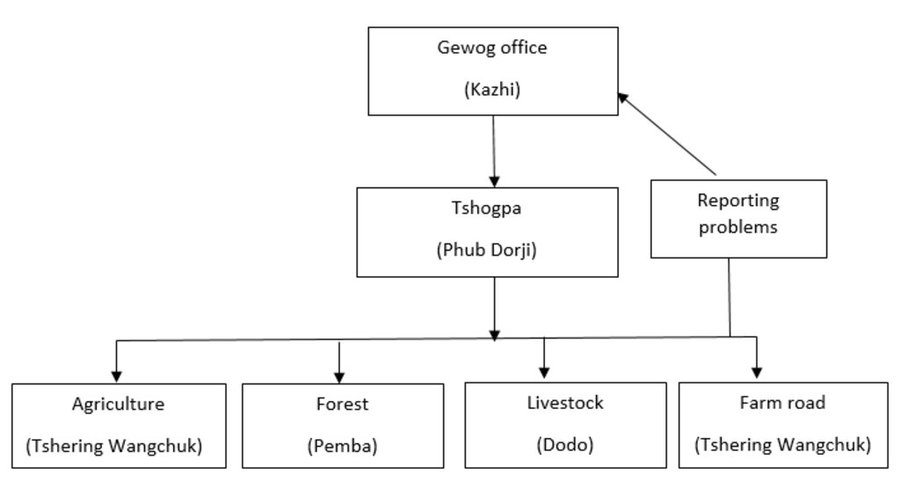
المؤلف: Niki Rai
اتخاذ القرار بشأن اختيار تقنية الإدارة المستدامة للأراضي
وقد تم اتخاذ القرارات من قبل
-
مستخدمو الأراضي وحدهم (المبادرة الذاتية)
-
مستخدمو الأراضي بشكل أساسي، بدعم من متخصصي الإدارة المستدامة للأراضي
-
جميع الجهات الفاعلة ذات الصلة، كجزء من نهج تشاركي
-
متخصصون في الإدارة المستدامة للأراضي بشكل أساسي، بعد التشاور مع مستخدمي الأراضي
-
متخصصون في الإدارة المستدامة للأراضي بمفردهم
-
السياسيون / القادة
تم اتخاذ القرارات بناء على
-
تقييم المعرفة الموثقة جيدًا بشأن الإدارة المستدامة للأراضي(اتخاذ القرارات القائمة على الأدلة)
-
نتائج البحوث
-
خبرة وآراء شخصية(غير موثقة)
الدعم الفني وبناء القدرات وإدارة المعرفة
شكلت الأنشطة أو الخدمات التالية جزءًا من النهج
-
بناء القدرات/التدريب
-
خدمة استشارية
-
تعزيز المؤسسات (التطوير التنظيمي)
-
الرصد والتقييم
-
البحوث
بناء القدرات/التدريب
تم تقديم التدريب للأطراف المعنية التالية
-
مستخدمو الأراضي
-
موظفون ميدانيون/ مستشارون
شكل التدريب
-
في العمل
-
من مزارع إلى مزارع
-
مناطق العرض
-
اجتماعات عامة
-
دورات
المواضيع المغطاة
Land users were provided with wide range of training targeting towards organic farming practices. The training was provided on Low Cost Plastic House Construction, Soil fertility Management (Composting & Vermi Composting), Nursery raising & transplanting, Bio Pesticide preparation and application and Post Harvest Management practices focusing on target crops. Further they were also provided with study tour to ARDC Bajo to update on the latest technology targeting on Soil fertility and Bio Pesticide management besides Bio Char preparation.
خدمة استشارية
تم تقديم الخدمة الاستشارية
-
في حقول مستخدمي الأراضي
-
في مراكز دائمة
Advisory services are provided from Gewog Agriculture Extension Supervisor/ Dzongkhag Organic Focal, ARDC Bajo, National Center for Organic Agriculture (NCOA).
تعزيز المؤسسات
تم تعزيز/إنشاء المؤسسات
-
لا
-
نعم، قليلا
-
نعم، باعتدال
-
نعم، إلى حد كبير
صف المؤسسة والأدوار والمسؤوليات والأعضاء وما إلى ذلك.
They are able to produce organic products for their self consumption and also able to supply to other institutions like schools and to the common vegetable markets.
نوع الدعم
-
مالي
-
بناء القدرات/التدريب
-
معدات
-
Seeds, Bio Fertilizers, Bio Pesticides/Fungicide, Low Cost & Prefabricated Plastic House, Electric Fencing Materials & Grass cutter.
مزيد من التفاصيل
Land users were provided with inputs (Improved Seeds, Bio-Fertilizers, Bio-Pesticide and Fungicide) at the initial stage prior to the capacity building. After the training, the inputs that land users can afford were gradually lifted through timely consultation meetings. The crucial inputs that the land users can't afford were included in the plan - and they were supplied with electric fencing materials to mitigate crop depredation from wild pests followed by a grass cutter for timely weed management within and around the field.
الرصد والتقييم
Monitoring and evaluation were done during the field visit to assess the physical progress by Extension Supervisor, Dzongkhag Agriculture Office & NCOA followed by consultation meetings where progress are reviewed and new plan were proposed. This progress and plan were finally submitted to NCOA, Dzongkhag Agriculture Office and Gewog Administration annually.
التمويل والدعم المادي الخارجي
الميزانية السنوية بالدولار الأمريكي لمكون الإدارة المستدامة للأراضي
-
< 2000
-
10,0000-2,000
-
100,000-10,000
-
1,000000-100،000
-
> 1,000,000
Precise annual budget: 4000.0
GEF-LCDF
تم تقديم الخدمات أو الحوافز التالية لمستخدمي الأراضي
-
الدعم المالي/المادي المقدم لمستخدمي الأراضي
-
إعانات لمدخلات محددة
-
الائتمان
-
حوافز أو وسائل أخرى
الدعم المالي/المادي المقدم لمستخدمي الأراضي
Funding in the initial set up was provided by GCF-LCDF- which stands for Global Environment Facility-Least Developed Countries Fund
معدات: الآلات
Rice milling machine and other processing machine
معدات: الآلات: أدوات
Green house
Electric fencing materials, Grass cutter
العمل من قبل مستخدمي الأراضي كان
-
تطوعي
-
الغذاء مقابل العمل
-
مدفوع نقدا
-
مقابل دعم مادي آخر
تحليل الأثر والتصريحات الختامية
آثار النهج
لا
نعم، قليلا
نعم، باعتدال
نعم، إلى حد كبير
هل ساهم النهج في تمكين مستخدمي الأراضي المحليين وتحسين مشاركة الأطراف المعنية؟
Improved community relationship and led to greater involvement of the stakeholders and commitment of the producer
هل مكّن النهج من اتخاذ القرارات المبنية على الأدلة؟
Land users proposal while planning has been improved from the initial. They can prioritize their needs towards strengthening organic farming.
هل ساعد النهج مستخدمي الأراضي على تنفيذ وصيانة تقنيات الإدارة المستدامة للأراضي؟
Organic farming practices improves sustainable use of resources ultimately resulting in conserving natural resources and increasing soil fertility
هل نجح النهج في تحسين التنسيق والتنفيذ الفعال من حيث التكلفة لأنشطة الإدارة المستدامة للأراضي؟
Improved livelihoods through higher income generation and reduced production cost
هل أدى النهج إلى تحسين معرفة وقدرات مستخدمي الأراضي على تنفيذ الإدارة المستدامة للأراضي؟
There is an exchange and learning platform among the stakeholders
هل أدى النهج إلى تحسين معرفة وقدرات الأطراف المعنية الأخرى؟
The approach involves a participatory decision making process.
هل ساهم النهج في بناء/تعزيز المؤسسات والتعاون بين الأطراف المعنية؟
The group is encouraging and influencing other local communities and has been learning site disseminated through television.
هل ساهم النهج في التخفيف من حدة الصراعات؟
Enhance team work, collaboration and cooperation among community and stake holders
هل ساهم النهج في تمكين الفئات المحرومة اجتماعيا واقتصاديا؟
This approach helped financially unstable farmers to improve their livelihood
هل أدى النهج إلى تحسين المساواة بين الجنسين وتمكين النساء والفتيات؟
No gender bias
هل شجع النهج الشباب/الجيل القادم من مستخدمي الأراضي على الانخراط في الإدارة المستدامة للأراضي؟
The evidence based learning through hands on training and study tour to ARDC Bajo has encouraged the young people currently in the community while those young students attending during the break and social influence are encouraging the young generations to take up the organic farming in the future.
هل أدى هذا النهج إلى تحسين الأمن الغذائي / تحسين التغذية؟
The approach of organic farming provided healthy production leading to improved food security and nutrition.
هل أدى النهج إلى تحسين الوصول إلى الأسواق؟
No specific market outlet for un processed organic product especially fresh vegetables though follow up are being done by Dzongkhag with opening of Organic Market Outlet at Bajo Town.
هل أدى النهج إلى تحسين الوصول إلى المياه والصرف الصحي؟
There is no usage of chemical fertilizers resulting in the reduction in pollution.
هل أدى النهج إلى استخدام طاقة/ مصادر طاقة أكثر استدامة؟
This approach is an integrated human, environment and sustainable agriculture production system while reducing external inputs like use of synthetic fertilizers and other harmful chemical pesticide.
هل أدى النهج إلى توفير فرص عمل ودخل؟
Young generations are being encouraged to adopt organic production systems
المحفز الرئيسي لقيام مستخدمي الأراضي بتنفيذ الإدارة المستدامة للأراضي
-
زيادة الإنتاج
-
زيادة الربح (القدرة)، وتحسين نسبة التكلفة إلى العائد
-
الحد من تدهور الأراضي
-
الحد من مخاطر الكوارث
-
انخفاض عبء العمل
-
المدفوعات/ الإعانات
-
القواعد واللوائح (الغرامات) / الإنفاذ
-
الوجاهة والضغط الاجتماعي/التماسك الاجتماعي
-
الانتماء إلى حركة/ مشروع/ مجموعة/ شبكات
-
الوعي البيئي
-
العادات والمعتقدات والأخلاق
-
تعزيز المعرفة والمهارات في مجال الإدارة المستدامة للأراضي
-
تحسينات جماليية
-
التخفيف من حدة الصراع
استدامة أنشطة النهج
هل يمكن لمستخدمي الأراضي الحفاظ على استدامة ما تم تنفيذه من خلال النهج (بدون دعم خارجي)؟
Organic production encourage long term commitment to maintain soil fertility, particularly addressing soil erosion, degradation and desertification and also reduce external energy consumption and reduce water use
الاستنتاجات والدروس المستفادة
نقاط القوة: وجهة نظر مستخدم الأرض
-
Low cost of investment and low external input use
-
Higher prices for organic products provide higher earning for producer involved in production, processing and trade hereby benefiting the small farmers
نقاط القوة: وجهة نظر جامع المعلومات أو غيره من الأشخاص الرئيسيين لمصدر المعلومات
-
Provide awareness and knowledge among the producers about organic farming techniques
-
Increase international organic market and provide niche export market for Bhutanese farmers that can comply with organic standards
-
Provide a platform for business development in producing organic products and processing high value organic products(manufacturing)
نقاط الضعف / المساوىء / المخاطر: وجهة نظر مستخدم الأرضكيفية التغلب عليها
-
Labor intensive
Mechanization
-
Lack of knowledge on organic production
Hands on training on organic production
-
Lack of specific market for organic production
Need support policies from high levels
نقاط الضعف / المساوىء / المخاطر: وجهة نظر جامع المعلومات أو غيره من الأشخاص الرئيسيين لمصدر المعلوماتكيفية التغلب عليها
-
Certification is costly for small farmers and could be a serious barrier to access a market that will require certification in future.
Proper legal framework and policies for farmers with affordable price in future.
-
Limited awareness in the domestic market about nutritional, safety and quality of organic farm produce
More awareness in the market as well as consumers,
المراجع
المُراجع
-
William Critchley
-
Rima Mekdaschi Studer
-
Joana Eichenberger
تاريخ التوثيق: 9 يوليو، 2023
اخر تحديث: 4 يونيو، 2024
الأشخاص الرئيسيين لمصدر المعلومات
-
Pemba - مستخدم الأرض
-
Phub Dorji - مستخدم الأرض
-
Dodo - مستخدم الأرض
-
Tshering Wangchuk - مستخدم الأرض
-
Tshering Wangchuk - مستخدم الأرض
الوصف الكامل في قاعدة بيانات WOCAT
بيانات الإدارة المستدامة للأراضي المرتبطة
تم تسهيل التوثيق من قِبَل
المؤسسة
- National Soil Services Centre, Department of Agriculture, Ministry of Agriculture & Livestock (NSSC) - بوتان
المشروع
- Strengthening national-level institutional and professional capacities of country Parties towards enhanced UNCCD monitoring and reporting – GEF 7 EA Umbrella II (GEF 7 UNCCD Enabling Activities_Umbrella II)
المراجع الرئيسية
-
National framework for organic farming in Bhutan, Department of Agriculture, 2006: website
-
Model organic village prospering, Chenga Dorji, 2022: website, BBS
روابط للمعلومات ذات الصلة المتوفرة على الإنترنت
